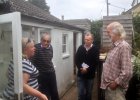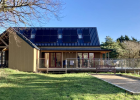23 Sep - 1 Oct 2022
Please get in touch at dorsetgreenerhomes@gmail.com if you would like to discuss our home or to come and visit
This event has now finished.
Other Tours
When Gregg and Rachel moved into this old chapel and rectory, the house was heated by a 25 year old il boiler, an Aga and open fires, with very little insulation, and damp areas in the kitchen. Since then they have worked on retrofitting the house, doing most of the work themselves, to create a dry, warm and efficient home. This involved learning about insulation in wall, floor and ceilings and managing the project themselves.
In the kitchen they took up the concrete floor and laid 300mm of glass foam hardcore, designed to compact ot 200mm, with excellent insulation properties while remaning breathable The roof area above the kitchen was limited, and they decided to install celotex sheets as there was not enough room for more natural materials.
In the main part of the house they installed internal insulation, building a 50mm timber frame and filing it with sheeps wool downstairs ( as it has to cope with damp) and wood fibre upstairs. Inside the walls are plastereed with lime-based solution to permit the flow of moisture. The front windows are single pane sash windows with conservation protection, so they installed secondary double glazing.
The roofs have PV solar panels which produce 8.7kW. Spare electricity is diverted with an Eddi to the immersion heater in the hot water tank, which produces all the hot water needed from March to September. In the winter they heat water and the house with a Dakin heat pump. Underfloor heating us covered with a limecrete screed to maintain breathability.
They are considering a battery system, but are waiting for the technology to evolve. The next stage is to install a Mechanical Ventilation Heat Recovery (MVHR) in the kitchen and utility room to dry the rooms while retaining all the heat.
The large garden remains a haven for wildlife, with free ranging chickens and small children, a productive vegetable garden, a polytunnel and fruit cages. Rainwater from the roof of the polytunnel, and from the house is collected in 5000litre IBC tanks, and is pumped from one to the other, and to the garden hose, with a pump connected to a 12 V battery, which in turn is charged by a separate PV panel.
The owners have had to deal with a large variety of problems to do with insulation and damp in an old house, and theu have become experts on retrofitting difficult buildings.
This event has now finished.
.jpg)

